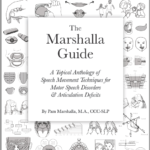Entrance and Exit Criteria

With every job I’ve ever had the administration, in an effort to decrease numbers always wants the speech language pathologists to develop Entrance and Exit criteria. This comes up every few years. Most schools will pull out an old document written in 1988 or so that is apparently their formal E&E criteria. This document is usually very vague and no one even knew it existed. I picture the therapists from the 80ies with big hair and scarves around their necks putting together something to appease the administration and to account for their consulting time together. I also picture one therapist doing most of the work by hand the night before it was due.
I have never worked in a system that “made” the therapists follow their E&E criteria. Still every system thinks this is a good idea. In theory I understand what they are going for and why they want it. Staffing is short, money is tight and we really don’t want kids missing too much class time. However, for administrators to say lets create E&E criteria and think this will solve any of the therapy woes they are sorely mistaken and once again it’s clear that they don’t understand how speech language pathologists function.
When we use standardized testing, specific guidelines have been created within those tests and subtests to determine the child’s level of functioning. This has been done through trials, studies and research in a very formal manner to make the testing reliable. It’s all written in the parts of the manual we don’t usually read. With most of our testing if skills fall below 1 standard deviation of average, the child is suspected of having a disability. Then we use our skills to look at the overall testing to analyze irregularities such as gaps between subtests and other testing, manner of performance during testing, we might look at item analysis to see if there’s a specific patterns, we might compare skills to cognitive ability, we consider other testing and a whole host of things. Today we also look at how students function within the classroom setting and how well they scored on state mandated testing before the team determines services. (Unfortunately these days a kid might not get the service they need if they have been too well trained in how to take state mandated tests and received a good score there or too many kids are pushed toward direct services because they haven’t achieved a good score) Given all those variables and the fact that every child is totally unique, it is almost impossible to come up with specific E&E criteria. As therapists we could come up with hundreds of scenarios where the students did not fit the one standard deviation below pattern, but the kids clearly needed services.
I have read some E&E criteria over the years that says not to pick up a student unless they are 1 1/2- 2 standard deviations below average. I always found that strange since the testing guidelines in the manuals are always clear on what they consider below average. I’ve always interpreted that as the school system saying “all our students are low functioning, you’re nothing special, not low enough.” If that is the case in any school there is something wrong with their curriculum.
I think our Entrance and Exit criteria guidelines are pretty well defined by the tests we give. For a school system to make up their own guidelines that are less strenuous than the ones provided in standardized testing is very arrogant. I would also have to wonder how these decisions would hold up in court if ever questioned.
Below is a very quick survey on Entrance and Exit Criteria. I want to know what other schools use for E&E criteria. I’m hoping to find documents and ideas out there that are different than the ineffective ones I’ve seen over the years.
Press next to proceed to the survey







